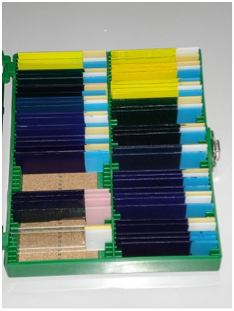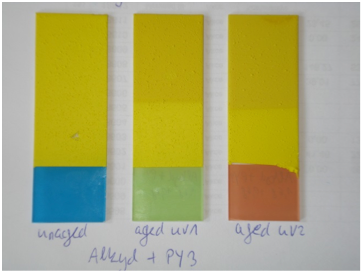NEWS
First phase (1th year):
Preparation, artificial ageing and analysis of paint layer mock-ups containing synthetic organic pigments (SOPs) and acrylic/alkyd binder
Preparation of paint layer mock-ups (December 2013)
In order to get simple paint systems for first MeV SIMS measurements and to avoid the influence of additives which usually can be found in commercial tube paints used by the artists, in first step 2-component paint mock-ups were prepared. Therefore selected blue and green phthalocyanine pigments as well as yellow azo-pigments were mixed with acrylic and alkyd binder. The paint layers were casted onto the glass slides, dried and applied to the accelerated ageing.
Pigments used:
Blue:PB 15:1, PB 15:3, PB 15:6, PB 16
Green:PG 7, PG 36
Yellow: PY 3, PY 74
Binders:
Acrylic: Plextol B 498 (Kremer Pigmente, Germany)
Alkyd: Oil, Medium 4 (LUKAS, Germany)
For comparison purposes, in second step, commercial paints (Winsor & Newton,U.K. and Schmincke, Germany) containing the same pigments and an acrylic and alkyd binder (detailed description of the binder is usually not given on the tube) were prepared also on glass slides, dried for 2 weeks and applied to accelerated ageing.

Paint Mock-Ups, ©INTK, Vienna
Artificial Ageing (January-June 2014)
Paint mock-ups were artificially aged in the UV chamber UVACUBE SOL2/400F (Dr. Höhnle AG, Germany).
Radiation spectrum: between 295 nm and 3000 nm (comparable with the sunlight radiation)
The lamp (Xenon arc solar simulator) irradiation: 910 W/m2
(Average irradiation of sunlight in Germany is e.g. 137 W/m2 per year).
Time period of accelerated ageing: 2 months (UV1) and 4 months (UV2)
Thus, 2 months ageing in the UV chamber can be approximately compared to 13 months ageing under natural sunlight amount. Further, we have to consider that the accelerated ageing in UV chamber was done continuously for 2 or 4 months without night/day and winter/summer cycles which are obvious during natural ageing.

Paint mock-ups, unaged, aged UV1 and aged UV2 ©INTK, Vienna

Commercial mock-ups with PY3 and alkyd binder, unaged, aged UV1 and aged UV2 ©INTK, Vienna
Analysis of mock-ups
Unaged (reference) and UV1 and UV2 aged mock-ups are analysed different analytical methods: FTIR-ATR, µ-Raman spectroscopy, Py-GC/MS, and MeV SIMS.
The aim of the measurements:
The identification of different phthalocyanine blue and green pigments (e.g. different polymorphs of PB 15), yellow azo-pigments as well as the characterisation of the ageing products at the surface of the samples using MeV SIMS method.
(FTIR-ATR, Raman and Py-GC/MS were used for comparative measurements supporting the first application of MeV SIMS in cultural heritage field)
MeV-SIMS molecular spectra for synthetic organic pigments used in modern and contemporary art works are collected in order to produce SOP database
All pure pigments used in the framework of the project as well as some additional pigments out of the project were measured with the MeV-SIMS method in order to establish the first MeV-SIMS mass spectra database for synthetic organic pigments.

Pure synthetic organic pigments on In mount
Method for molecular imaging at the submicron level was developed
For molecular mapping at submicron level, the beam spot size of the existing MeV-SIMS systems, which is typically several microns, is to large and has to be reduced. In order to improve the resolution of the lateral beam, the trigger for the TOF - START was replaced with a timing signal that is provided by a silicon charged particle detector that is used for Scanning Transmission Ion Microscopy (STIM). Reduction of the beam current is performed by closing the object and collimator slit openings, thus decreasing divergence of the ion beam. This leads to a significant reduction of the ion beam spot size (below 1 µm) using the same focusing elements. With this approach, the same beam current was achieved as with the pulsed ion beam mode, but the beam lateral dimension was reduced by more than an order of magnitude (down to 300 nm). Altogether, due to the well-defined submicron beam focus and the high sensitivity, molecular imaging at the submicron level was achieved with MeV-SIMS.

